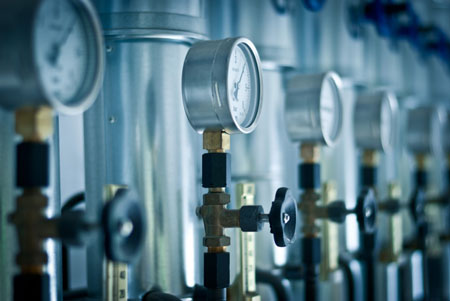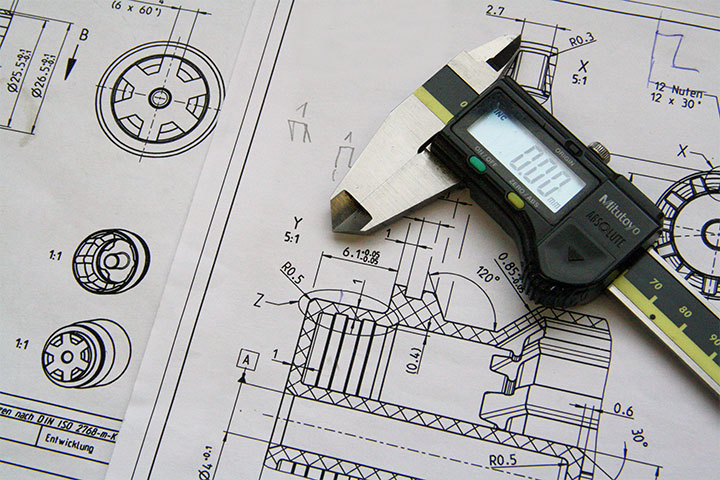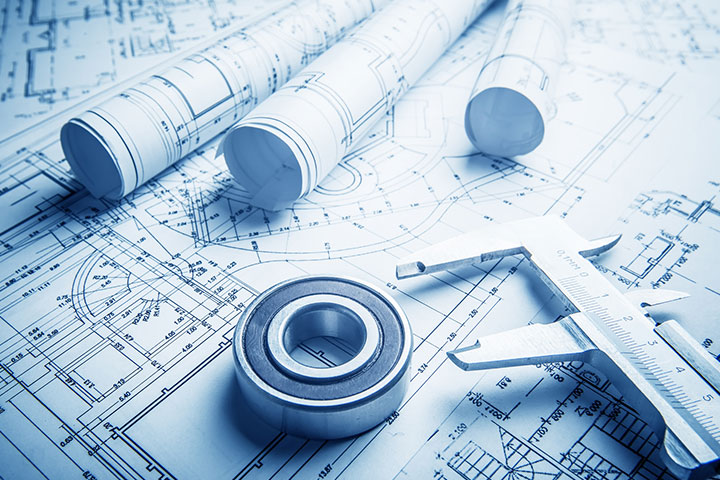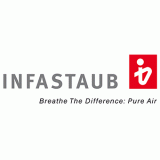
The energy, chemical, oil and gas processing equipment such as pressure vessels, industrial piping, steam generators, boilers and pressure accessories belongs to the category of overpressure operated devices called pressure equipment.
The pressure equipment is a separate group, which includes potentially dangerous equipment, for which particularly high safety requirements are defined. For this reason, a technical regulation has been developed in the Eurasian Economic Union (EAEU), which sets strict requirements for industrial safety and reliability of pressure equipment.
Legal framework
On July 2, 2013 the technical regulation TR CU 032/2013 On safety of pressure equipment came into force and established standard safety requirements for pressure equipment and its marking. This regulation has been developed in accordance with the European Directives on Pressure Equipment 97/23/EG, 2009/105/EU and 2010/35 /EU.
Application area
Pressure equipment within the Eurasian Economic Union (EAEU) is subject to strict regulatory control, as any device operating under pressure poses increased technical and operational risks. Therefore, products that generate, contain, or transport pressurized media must comply with the requirements of Technical Regulation.
The regulation applies once the maximum allowable pressure exceeds 0.05 MPa (0.5 bar). Any vessel, assembly, pipeline, or component designed to operate above this threshold is considered pressure equipment and must meet the established safety requirements. The scope covers equipment handling pressurized gases, vapors, or liquids, ensuring safe design, manufacturing, conformity assessment, and operation.
The TR CU 032/2013 applies to:
- vessels
- piping
- boilers and steam generators
- pipeline valves
- indicators
- parts of equipment with a safety function
- pressure-bearing components
The TR CU 032/2013 does not apply to:
- main pipeline
- gas distribution network
- equipment for use in the field of nuclear energy
- equipment for use on sea and inland waterways
- brake systems of rail vehicles
- container for use on airplanes
- munitions
- parts of machines which are not self-contained containers (housings of pumps, turbines, compressors or motors)
- medical individual pressure chambers
- sprayers
- housing of high voltage equipment
- non-metallic flexible containers
- muffler and silencer
- containers for carbonated beverages which are intended for final consumption
Conformity assessment
In order to import the pressure equipment to Russia and countries of the Eurasian Economic Union, a certificate of conformity of compliance with the requirements of the Technical Regulation TR CU 032/2013 is required. The pressure equipment is subject to EAC Certification or EAC Declaration according to the TR CU 032/2013.
The equipment and the corresponding conformity assessment procedure are divided into 4 groups of hazard. Less hazardous equipment is classified in category 1, particularly hazardous pressure equipment in category 4. The following criteria are decisive for classification:
- maximum permissible pressure (PS)
- volume (m3) or nominal width (mm)
- the product of maximum permissible pressure and volume or nominal width
Depending on the processing medium (gas or liquid) or group of applied substances are assigned to group 1 or 2 as follows:
- Group 1: hazardous substances (Flammable, oxidizing, combustible, explosive and toxic gases, liquids and vapours)
- Group 2: other substances not mentioned in Group 1
With our Pressure equipment category calculator you can determine which category your equipment belongs to:
The EAC Certification according to TR CU 032/2013 is needed for pressure equipment of hazardous classes 3 and 4, that are listed in Appendix 1 of the technical regulation.
The EAC Declaration according to TR CU 032/2013 is required for pressure equipment of hazardous classes 1 and 2.
The certification process depends on whether it is a contract delivery, serial production or delivery of components. In case of serial production, a manufacturing audit is usually required.
If pressure devices or assemblies are subject to conformity assessment according to several technical regulations of the EAEU, in which a proof of conformity is required, the products must be certified or declared according to all related technical regulations.
For example, the industrial accessories for pressure equipment are subject to the confirmation of conformity according to TR CU 032/2013, as well as it is subject to the EAC declaration according to TR CU 010/2011 On safety of machinery. If these accessories are equipped with electrical controls, they should also conform to the requirements of TR CU 004/2011 On safety of low voltage systems and TR CU 020/2011 On electromagnetic compatibility.
In contrast to many other technical regulations, TR CU 032/2013 does not provide the possibility to replace the EAC declaration by the EAC certification at the request of the applicant.
The proof of conformity is issued for up to five years.
Required documents:

- general description of the pressure equipment
- vessel passport
- safety justification with risk assessment
- instruction manual
- strength calculations
- technical passport of protective device
- technical drawings
- test reports
- quality certificates and approvals at hand
- ISO 9001 Certificate
EAC conformity assessment schemes
Schemes of EAC declaration
| Scheme | Description |
|---|---|
| 1D | is intended for series production for equipment of the hazard class 1,2. This scheme requires the type examination of product samples. Type examination of product samples is carried out by the manufacturer. |
| 2D | is intended for a batch delivery or a single delivery for equipment of the hazard class 1,2. This scheme requires the type examination of product samples. Type examination of product samples are carried out by the manufacturer. |
| 3D | is intended for series production for equipment of the hazard class 1,2. This scheme requires product samples to be tested by a laboratory accredited by the EAEU. |
| 4D | is intended for a batch delivery for equipment of the hazard class 1,2. This scheme requires product samples to be tested by a laboratory accredited by the EAEU. |
| 5D | is intended for equipment of the hazard class 1,2,3,4 if they can be completed only on the territory of the factory. This scheme is used if no type examination can be carried out until these devices have been completed at the operating site and if no standards specified in TR CU 032/2013 have been applied.
This scheme requires product samples to be tested by a laboratory accredited by the EAEU. |
Schemes of EAC certification
| Scheme | Description |
|---|---|
| 1C | is intended for series production for equipment of the hazard class 3,4. In this case, samples are to be tested and a manufacturing audit is to be carried out. The EAC certificate is issued on the basis of the test report, examination of technical documents and results of the audit.
An inspection control must also be carried out every year. |
| 3C | is intended for a batch delivery for equipment of the hazard class 3,4. In this case, samples are also to be tested. |
| 4C | is intended for a single delivery for equipment of the hazard class 3,4. In this case, samples are also to be tested. |
| 7C | is intended for series production for equipment of the hazard class 3,4. In this case, samples are to be tested and a manufacturing audit is to be carried out. The EAC certificate is issued on the basis of the test report, examination of technical documents and results of the audit. |
Conformity assessment of parts of equipment with a safety function and indicators
Parts of equipment with a safety function and indicators are also subject to the requirements of TR CU 032/2013.
Parts of equipment with a safety function are devices that are designed to protect the pressure equipment if the permissible pressure or temperature limits are exceeded. Parts of equipment with a safety function belong to the 4th category and are subject to EAC certification according to TR CU 032/2013.
Indicators are such devices as sight glasses, level indicators, gas and liquid flow indicators and other similar technical devices that are not measuring devices.
Measuring devices such as termometers, barometers, vacuum meters and gas meters are not subject to any EAC conformity assessment. An exemption letter must be issued for these devices instead. Please note that measuring devices may require a metrological approval certificate.
Conformity assessment of pressure equipment, the working media of which is in the liquid and gaseous state
When assessing the conformity of pressure equipment, the question often arises of how to choose the form of conformity confirmation if the working medium is in two states: liquid and gaseous. Rostekhnadzor answered this question.
The main danger for pressure equipment is the energy reserve of the working medium, which is located in the closed space of the container body, the value of which depends on the pressure, temperature, volume, properties and physical state of the medium.
The greatest risk is the working medium in the gaseous state. A medium in the gaseous state has the property of reducing its volume with increasing pressure up to a liquefied state and increasing the pressure with increasing temperature. If the pressure equipment is destroyed during operation, an uncontrolled process of pressure drop occurs with an increase in the volume of the media pressurized in it in a gaseous, liquefied or dissolved state, which leads to further destruction and the formation of a pressure wave.
Since the main criterion in the Technical Regulation TR CU 032/2013 is pressure, the conformity assessment of pressure equipment is determined as follows:
- The category of devices that are under the pressure of media in two aggregate states (liquid and gas) should be determined according to the part of the medium that gives the highest category and poses the greatest risk
- The category of equipment operating under the pressure of liquefied gases is determined by gas
Conformity assessment of pressure gauges (manometers)
For pressure gauges used in industrial settings, obtaining the proper certification is essential. Two key documents are required:
- EAC Certificate of Conformity TR CU 032/2013: This certificate confirms that the pressure gauge meets the safety requirements for equipment operating under pressure, as established by the technical regulations of the Eurasian Economic Union (EAEU). It serves as proof that the device can be reliably and safely used in high-pressure environments.
- GOST Type Approval (PoA) for Measuring Instruments: the Pattern of Approval verifies that the pressure gauge has passed all necessary tests and provides accurate measurements. This certification is critical for devices where precision is vital, ensuring readings fall within acceptable tolerances and supporting the proper functioning of industrial processes.
Holding both certificates allows manufacturers and distributors of measuring instruments to legally supply their products throughout the EAEU. The EAC Certificate is valid for five years across all member states, while the GOST PoA — which details the device’s purpose, scope, specifications, measurement accuracy, and calibration intervals — is also valid for five years. Manufacturers and suppliers can apply to extend the GOST PoA after its expiration, maintaining uninterrupted access to the market.
Registration of a Certificate for a medical manometer (tonometer)
Medical manometers, or tonometers, are precision instruments designed to measure arterial blood pressure. Due to their direct influence on patient health, these devices must undergo strict verification through official certification:
Registration Certificate from Roszdravnadzor (RF PP No. 1416): issued by the Federal Service for Surveillance in Healthcare (Roszdravnadzor) in Russia, this certificate is mandatory for all medical devices. It confirms that the tonometer complies with established safety and effectiveness standards for medical use. Unlike industrial certifications, this registration does not expire, providing long-term authorization for clinical application.
GOST R Declaration (RF PP No. 982): alongside the registration certificate, a GOST R declaration is required to demonstrate conformity with Russian national standards (GOST R). This declaration typically has a validity of up to three years and must be renewed periodically to maintain compliance with updated medical regulations.
Together, these documents ensure that medical tonometers are legally approved for use in healthcare settings, guaranteeing both accuracy and patient safety.
Authorized representative for pressure equipment certification
Manufacturers of pressure equipment and pressure vessels who are not established in a member state of the Eurasian Economic Union (EAEU) are not permitted to apply directly for conformity assessment under TR CU 032/2013 On safety of pressure equipment.
In order to be able to carry out a conformity assessment of pressure equipment, the foreign manufacturer must appoint an authorized representative in one of the member states of the Eurasian Economic Union.
This Authorized Representative serves as the official contact and legal representative of the foreign manufacturer in all matters related to pressure equipment certification, including interaction with EAEU certification bodies, ensuring compliance with the technical regulations, and overseeing product safety and quality assurance.
According to current legislation, only an operator based within the territory of the Eurasian Economic Union may be designated as an authorized representative. For European, American, or Asian producers, this is a mandatory prerequisite for certification and market access to the EAEU.
Schmidt & Schmidt assists producers from Europe, America, and Asia in designating an authorized representative within the EAEU. Through our legally compliant solution via Kazakhstan — an EAEU Member State — we ensure the issuance of EAC Certificates and EAC Declarations. With our local offices, we guarantee that the entire conformity assessment process not only complies with the technical regulations of the Eurasian Economic Union but is also conducted in accordance with European and American sanctions regulations. In this way, our clients gain reliable and lawful access to the EAEU market.
Compliance with EU and US sanctions Compliance with EU and US sanctions for pressure equipment in the EAEU market

When certifying and declaring the conformity of pressure equipment for the Eurasian Economic Union (EAEU) market, European and international manufacturers must ensure not only compliance with the technical regulations of the EAEU, particularly TR CU 032/2013 “On Safety of Pressure Equipment”, but also strict adherence to EU and US sanctions. These sanctions may affect the export of certain pressure vessels, components, or safety systems, as well as cooperation with listed individuals, entities, or certification bodies. They may also restrict the provision of engineering, consulting, or conformity assessment services to sanctioned jurisdictions. Failure to comply can lead to severe legal and financial consequences, including blocked shipments, suspended certification processes, and potential civil or criminal liability.
The issue is particularly sensitive for exports to Russia and Belarus. Since 2014, numerous embargoes and restrictive measures have been introduced, directly influencing the EAC conformity assessment of pressure equipment. For example, certain certification bodies, testing laboratories, or distributors in these countries may appear on sanctions lists, rendering any cooperation legally prohibited. Therefore, companies must ensure that not only their products but also all partners and intermediaries involved in the certification and logistics process are fully compliant with the latest EU and US regulations.
A significant risk also arises if shipments of pressure equipment are detained or blocked due to sanctions violations. Even a valid EAC certificate or declaration cannot guarantee legal protection in such cases. This makes close coordination between compliance departments, export control officers, and certification partners essential to avoid legal complications and maintain secure supply chains.
For manufacturers and exporters of pressure equipment seeking to access Kazakhstan, Russia, or other EAEU Member States, it is crucial to ensure both technical conformity and comprehensive sanctions compliance. This includes verifying the end-use and end-users of the products, as well as choosing reliable authorized representatives and local partners who meet all compliance requirements.
Schmidt & Schmidt provides a legally compliant solution via Kazakhstan. As a full EAEU Member State, Kazakhstan is authorized to issue both EAC Certificates and EAC Declarations. Through our local offices, we conduct conformity assessment procedures in strict alignment with EU and US sanctions regulations, helping our clients legally access the EAEU market while maintaining international compliance standards.
For detailed updates and guidance, please refer to our article: EAC Certification Amid EU and US Sanctions against Russia and Belarus.
EAC Marking

Products operating under overpressure, whose conformity with the requirements of TR CU 032/2013 has been confirmed, may be marked with the EAC mark of the Eurasian Economic Union. Placing products on the market without the appropriate marking may result in fines and seizure.
Requirements for the EAC Conformity Mark:
- Good legibility with the naked eye
- Dimensions of at least 5 mm
- Monochrome coloring or clear color contrast with the surface
- Good legibility throughout the entire service life of the product
Product and packaging marking
The following information must be indicated on the nameplate of the pressure equipment:
- Designation (type, model, brand)
- Safety-relevant technical characteristics
- Information about the materials from which the equipment is made
- Manufacturer’s trademark
- Manufacturing date
- Serial number
- EAC conformity mark
If the nameplate cannot be attached to the equipment, this information must be included in the user manual.
Period of validity of EAC conformity assessment certificates for pressure equipment
The validity period of the EAC certificate or EAC declaration for pressure equipment differs depending on the applied technical regulations, the selected scheme, the type of production (serial production, individual delivery, etc.) and equipment and ranges on average from one to 5 years. Those parameters are determined in the respective technical regulation.
Duration and costs for EAC certification
The duration and costs associated with an EAC certificate application for pressure equipment depend on several different factors, such as the classification of the product, any required laboratory checks and the complexity of all examinations. As such the exact conditions of the EAC certification are always determined individually based on the required documentation.
Please note that an application for an EAC certificate can takeseveral weeks to process.
Delivery of the documentation
If you order the EAC Certificate on Pressure Equipment, you will receive a copy of it via email immediately after our successful certification procedure. The original document and two certified copies will be sent by post.




















































